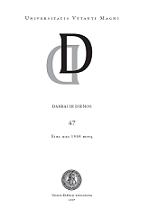Antisovietinės apraiškos ir nacionaliniai konfliktai pramonės įmonėse 1965-1985 m.
Anti-soviet tendencies and national conflicts in industrial enterprises, 1965-1985
Author(s): Saulius GrybkauskasSubject(s): History
Published by: Vytauto Didžiojo Universitetas
Keywords: Anti-soviet; tendency; national; conflict; industrial; enterprise; 1965; 1985;
Summary/Abstract: Soviet industry was an important area for the material activities of part of the Soviet society; it necessarily influenced society's way of life. Corporate work collectives, as separate communities of production, reflected perfectly the problems, worries and aspirations of society at that time. In the field of industry, Soviet economic, social and national policies, as well as societal controls implemented by the regime, became closely interrelated; they shaped both the reaction of workers and engineers to government initiatives and the relations between the various members of factories and plant work collectives. Changes in these relations were likewise affected. The article analyses conflicts, ethnic relations and anti-Soviet manifestations in plants and factories. During the Soviet era Lithuania underwent major economic and social changes which ushered in tensions and had great significance for the rise of both nationalism and ethnic conflicts. Khrushchev's thaw allowed political prisoners and deportees, repressed during the Stalin era, to return to Lithuania from exile. At the same time, due to the downsizing of the army and the KGB carried out during the Khrushchev years, former "chekists" (members of the secret service, the Cheka) and soldiers, whose mentality and views differed greatly from those of the former political prisoners and deportees, found 'sanctuary' in Soviet plants and factories. Subsequent industrial development and the immigration it caused served to spread and increase nationalism beyond a phenomenon that merely destroyed traditional ties. A factory or a plant was a convenient place for both anti-Soviet expression and ethnic competition. Big factories became favourite places for anti-Soviet proclamations and conversations deemed dangerously 'nationalistic'. Production and social problems arose; they constantly boiled over into ethnic strife. The inability or the reluctance of the Soviet regime to distinguish between simple everyday conversations about problems and deficiencies noticed by the workers and instances of (excessive) ethnic expression or criticism of the system itself caused great frustration; dissatisfaction grew. Social competition frequently acquired the characteristics of an ethnic conflict. Many people who were not faithful to the regime, those who had experienced repression under the Soviet occupation or had lost a high social position, transferred their hatred of the Soviet regime to their Russian colleagues. It is interesting to note that neither archival sources nor interviews touch upon Lithuanian — Polish conflicts in industrial factories. Apparently, as residents of the Vilnius region, Poles enjoyed the status of'local residents"; they were not outsiders. The fact that they had the same religious faith as Lithuanians seems to have also been a significant factor. Large numbers of local Poles in industrial factories began to merge with the labour force arriving in Vilnius from West Belarus.
Journal: Darbai ir dienos
- Issue Year: 2007
- Issue No: 47
- Page Range: 75-92
- Page Count: 18
- Language: Lithuanian

